 This is the front page of the final edition of the Albuquerque Tribune.
This is the front page of the final edition of the Albuquerque Tribune.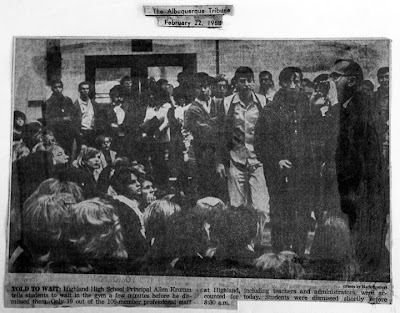 Forty years ago, yesterday, Feb. 22, 1968, this picture of mine was published on the front page of the Albuquerque Tribune; the caption read:
Forty years ago, yesterday, Feb. 22, 1968, this picture of mine was published on the front page of the Albuquerque Tribune; the caption read:TOLD TO WAIT: Highland High School Principal Allen Krumm tells students to wait in the gym a few minutes before he dismissed them. Only 19 of the 109-member professional staff at Highland, including teachers and administrators were accounted for today. Students were dismissed shortly before 8:30 a.m.
It was my first published front page, above the fold, paid daily newspaper picture. I was a junior at the high school and upon being dismissed, I processed the picture and within about an hour, I was throwing a print on Tribune Sports Editor Carlos Salazar’s desk. “You guys want to run this,” I asked? I knew Salazar. He knew my style of dropping sports photos on his desk because he had run several over the preceding year. He got up and went to the city desk with me in tow. The Editor of the day told Salazar yes and waved us away. That was it. Salazar filled out the payment form and about an hour or so later my picture hit doorsteps all over the city.
The wildcat teachers strike didn’t last very long and when classes resumed, I was “the news guy” on campus.
I never worked for the Tribune full time, but members of their staff have been colleagues and friends.

I’ve introduced you to several current and former Tribune employees in an earlier post.
There were others worth mentioning, including: Tribune photographer Al Cabral, who was one of the friendliest and easiest going guys I have ever met on a photo-line. Norm Bergsma, was also a photographer, who was one of, if not the toughest guys I have ever met on a photo-line. Bergsma could be mean; he once put tape over one of my extra camera lenses. I told him in no uncertain terms that I was capable of violence. Later, after leaving the Tribune, he ran the Sheriff’s photo lab and we got on quite well.
In 1972, I won two of the three photography categories in the Albuquerque Press Club APE Award contest, for sports and feature. As I recall, Bergsma won the news category for a series of pictures of a circus high wire act that fell.
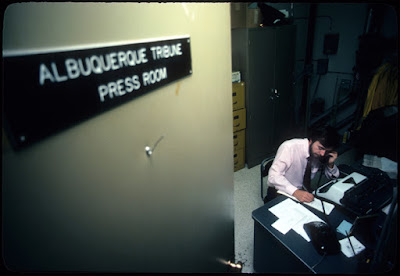 Tribune’s Police Beat Reporter Timothy Gallagher in 1978 worked in a storage closet, with sewer pipes, in the basement of the police department. He would go on to other jobs with the Scripps newspaper system, then return to Albuquerque to become the Tribune’s editor. At the time, Gallagher was one of the youngest editors of a daily newspaper.
Tribune’s Police Beat Reporter Timothy Gallagher in 1978 worked in a storage closet, with sewer pipes, in the basement of the police department. He would go on to other jobs with the Scripps newspaper system, then return to Albuquerque to become the Tribune’s editor. At the time, Gallagher was one of the youngest editors of a daily newspaper.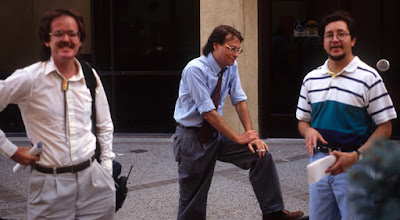 One of the best journalistic quips came from the Tribune’s City Hall Reporter Ed Asher, center, with Journal Police Reporter Steve Shoup, left, and the Tribune’s Police Beat Reporter Macario "Mac" Juarez Jr., right.
One of the best journalistic quips came from the Tribune’s City Hall Reporter Ed Asher, center, with Journal Police Reporter Steve Shoup, left, and the Tribune’s Police Beat Reporter Macario "Mac" Juarez Jr., right.“What’s happening,” I asked the reporters?
“For 50 cents you can read all about it in tomorrow’s paper,” Asher shot back.
There was an irony there; as a public servant, I had to answer Asher when he asked, “What’s happening,” yet I had to shell out 50 cents to find out what he had learned from me and others.
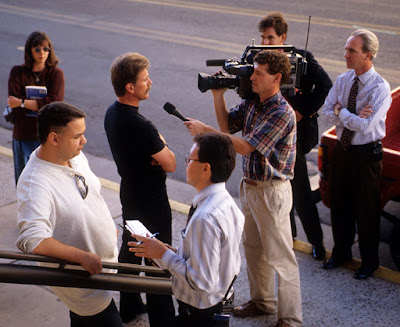 Tribune Reporter Juarez, in the foreground center, interviews APD Officer Donald McGrath, left, at an impromptu press conference in support of a 1995, quarter percent Public Safety Tax, on the front steps of the Law Enforcement Center. KOB Cameraman Carey Moots interviews Officer Lance Fleming, in the black t-shirt, while Rick Homans, partially hidden behind the camera, and Tom Carroll, right, who arranged the press event, for their pro-tax Safer Albuquerque committee, observe.
Tribune Reporter Juarez, in the foreground center, interviews APD Officer Donald McGrath, left, at an impromptu press conference in support of a 1995, quarter percent Public Safety Tax, on the front steps of the Law Enforcement Center. KOB Cameraman Carey Moots interviews Officer Lance Fleming, in the black t-shirt, while Rick Homans, partially hidden behind the camera, and Tom Carroll, right, who arranged the press event, for their pro-tax Safer Albuquerque committee, observe.Carroll, along with his advertising agency partner Doug Turner, recently withdrew a bid to purchase the Tribune from Scripps Newspapers. Carroll has since left the D.W. Turner Advertising Agency.
The most disquieting media encounter I experienced was in April 1996, when Juarez was waiting for me as I came to work one morning. He had a copy of a missing person’s report in his hand that I had written just weeks earlier.
I had taken a call from a woman reporting that her daughter, Cassandra Sedillo, 23, and her two grandchildren, Johnny Ray Garcia, 4, and Matthew Gene Garcia, 3, had gone missing. The woman had not seen them since around Thanksgiving. I had passed on the report to APD’s Missing Persons Unit. She had named a teenager, as I recall, “Popeye,” as having been with Sedillo and that they were going to the town of Torreon.
The decomposed bodies of the woman, her sons and her boyfriend, Ben Anaya Jr., 17, were found in the summer cabin of Anaya’s father, when he went to check on it after receiving a gas bill. Anaya Sr. knew he had shut down the cabin and had minimal bills through the fall. Sedillo and Anaya Jr. had been shot to death, while the children had not been harmed, but died of starvation. They had all been dead for months before I received the report. However, the thought of it all was very grim.
Four teenagers with affiliations to the 18th Street gang in Albuquerque’s South Valley were arrested, including Shawn "Popcorn" Popeleski, 18, as reported by the Tribune.
Popeleski and another suspect were convicted in the killings, while the other two went to trials that ended in hung juries. They were not retried and eventually released.
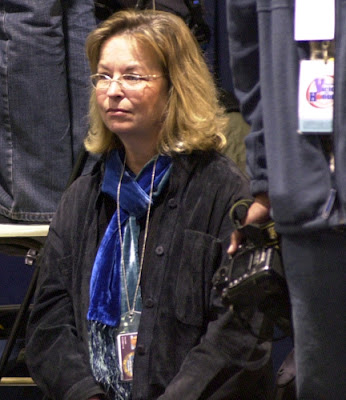 Veteran Managing Editor Kate Nelson, above, resigned from the Tribune after 18 years. She joined Lt. Gov. Diane Denish’s staff, as Deputy Chief of Staff and Communications Director, June 26, 2007. Her departure was just two months before the announced sale offer. With declining circulation, did she have an inkling or premonition of what was to come?
Veteran Managing Editor Kate Nelson, above, resigned from the Tribune after 18 years. She joined Lt. Gov. Diane Denish’s staff, as Deputy Chief of Staff and Communications Director, June 26, 2007. Her departure was just two months before the announced sale offer. With declining circulation, did she have an inkling or premonition of what was to come?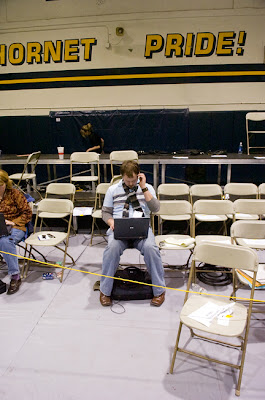 Albuquerque Tribune’s Political Reporter Erik Siemers, above, files a story after the recent visit of Sen. Hillary Clinton, D- N.Y., at Highland High School.
Albuquerque Tribune’s Political Reporter Erik Siemers, above, files a story after the recent visit of Sen. Hillary Clinton, D- N.Y., at Highland High School.So what’s wrong with this picture?
 This is the empty sales box for final edition of the Tribune after I spent my 50 cents. I had to look several places before locating the last paper.
This is the empty sales box for final edition of the Tribune after I spent my 50 cents. I had to look several places before locating the last paper.Six months ago, E.W. Scripps, the parent company of the Tribune, announced that the paper was for sale, without benefit of the joint operating agreement. If there weren’t a qualified buyer, the Tribune would close.
There is a fair amount of speculation about the continuation of the joint operating agreement. The JOA, as it is called in the newspaper trade, was formed during the depression to allow the Journal and Tribune to combine certain parts of the business, particularly: advertising, circulation, and the printing plant, while maintaining separate editorial and news gathering functions. In theory, a JOA would seem to violate anti trust and monopoly laws. However, in a case that went all the way to the U.S. Supreme Court, it ruled that the JOA was legal.
Scripps will continue to collect 40 percent residual interest in the Albuquerque Publishing Company, until 2022, when the JOA expires.
Some media observers in town consider the arrangement as appearing strange; collect profits for not putting out a product. However, it possibly is because Scripps made a sizable investment in the new publishing facility that is now more than 20 years old.
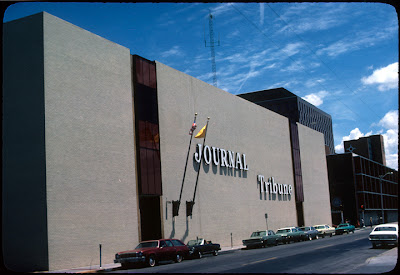 The Journal and Tribune moved from this downtown facility that they had shared since 1954. These photographs were from a 1978 photo essay on police press relations.
The Journal and Tribune moved from this downtown facility that they had shared since 1954. These photographs were from a 1978 photo essay on police press relations.Technology has changed. Forty years ago, headlines at the Albuquerque Publishing Company were still handset, though body type was produced using linotype composing machines.
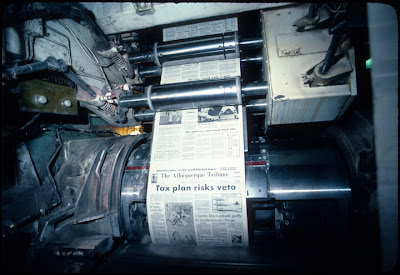 The way printing plates were produced changed with the technology.
The way printing plates were produced changed with the technology. For all the technology, there still is a human aspect to gathering the news, monitoring the print quality, and to distributing the papers.
For all the technology, there still is a human aspect to gathering the news, monitoring the print quality, and to distributing the papers.

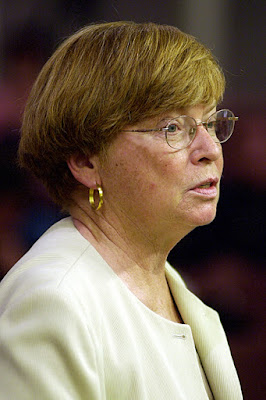 This picture of the City of Albuquerque’s Chief Financial Officer Gail Reese was used to illustrate a story about her adopting a pseudonym, “Linda,” to call her boss Mayor Martin Chávez’ Saturday radio talk show, to blast City Councillors. It was my most recent published front page, above the fold, paid daily newspaper picture.
This picture of the City of Albuquerque’s Chief Financial Officer Gail Reese was used to illustrate a story about her adopting a pseudonym, “Linda,” to call her boss Mayor Martin Chávez’ Saturday radio talk show, to blast City Councillors. It was my most recent published front page, above the fold, paid daily newspaper picture.Hopefully it’s not the last, but without the Tribune, the competition amongst journalists and photographers in town will increase. Amongst news outlets, the competition is weakened. I believe that no newspaper becomes better after their competitor goes away.
“Give light and the people will find their own way,” was the motto of the Tribune, written by its original Editor Carl Magee. The light has now gone out.
The -30- in the title of this posting is newspaper shorthand placed at the end of a story so that proofreaders, editors and linotype operators, knew they were at the end of a story.
 Today, after 86 years of publication, the Albuquerque Tribune is...
Today, after 86 years of publication, the Albuquerque Tribune is...-30-
2 comments:
great piece. Do you remember how much they paid you for your first picture, front page, above the fold, daily paper?
I worked with Norm Bergsma (can there be another?) at the Lorain, Ohio "Morning Journal" from 1968 to 1969. Yes he was a mean, tough guy but he was also an excellent photographer.
One shot I always admired Norm created during a severe Ohio winter blizzard. He went out to a rural area, found some kids coming home from school. The wind and snow were blowing so hard the kids were in a line bowed head down each reaching out to touch the one ahead as they forged their way into the storm. A strong, dramatic "weather shot". A real winner for above the fold.
Norm was the first on the "Morning Journal" staff to shoot color. He shot with his Hasselblad, processed his own 120 transparency film and worked with the printers to make the plates for the press. Back in the 1960s that was fairly advanced stuff.
After I moved on the the " Akron Beacon Journal" I lost track of Norm. But I did hear he was arrested during a Cleveland Indians baseball game for stealing lenses from a former "Morning Journal" staff photographer who was a former Marine and was not one to mess around with.
I had always wondered what happened to Norm.
Terry Thomas...
the photographer
Atlanta, Georgia
http://www.TerryThomasPhotos.com
Post a Comment